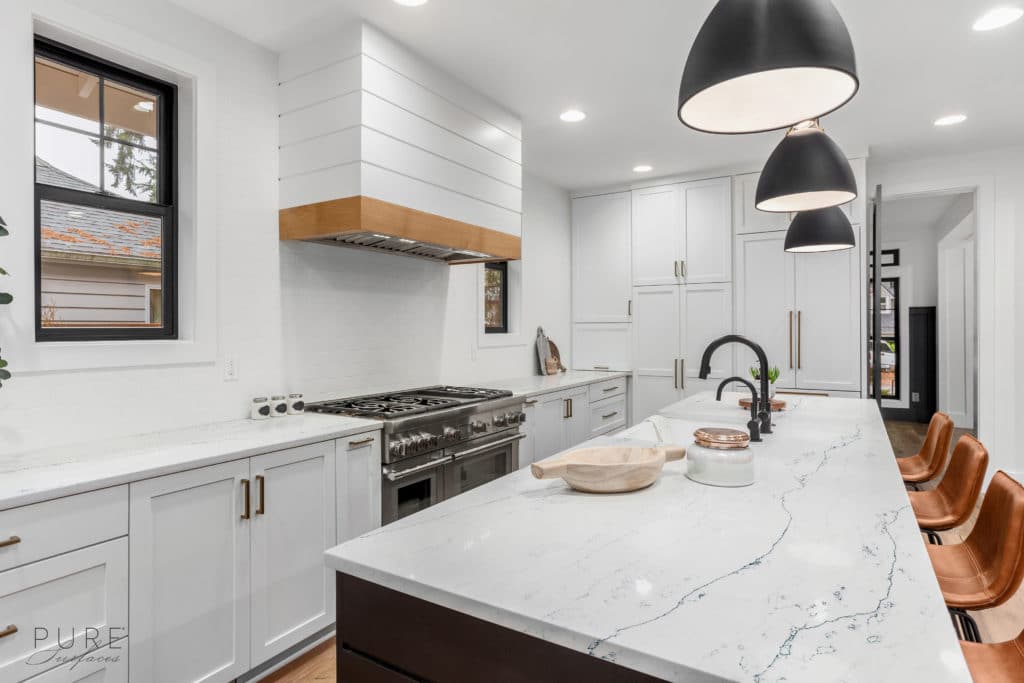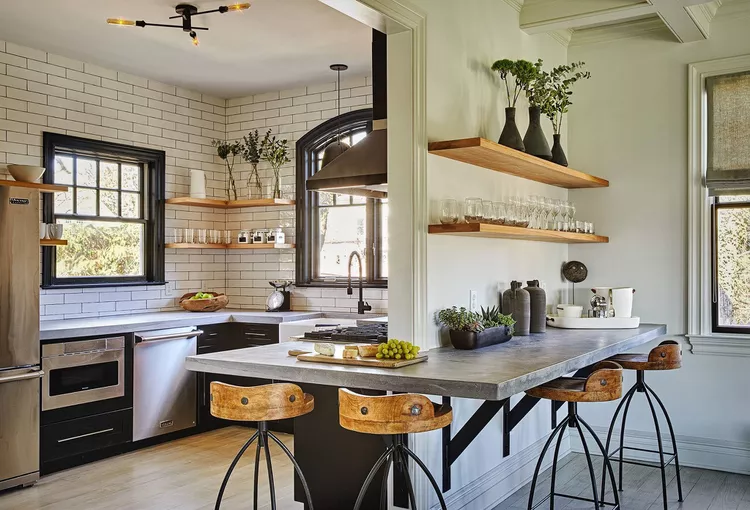26 Apr Kitchen Countertop Options
With so many surface choices available, how do you decide on the kitchen countertop that’s right for your space? There are multiple aspects to consider, including cost, durability and color options. Some homeowners prefer the traditional and impervious look of natural stone, while others opt for a more eco-friendly, recyclable product. So which one is right for your Denver kitchen remodel? Consider what pairs best with the overall design of your space, what your needs are, and what matches your personal style.
Granite
Granite is the classic, enduring choice with many advantages over other materials. It doesn’t chip easily, is heat and stain-resistant, is more low-maintenance than other natural stone materials, and offers a depth of design that’s difficult to match with synthetic materials. However, there also are disadvantages. If you damage your granite countertop, it’s very difficult to repair. It’s also the most expensive option of all the materials listed here. Although it’s considered relatively low maintenance, it needs to be sealed once a year to prevent it from absorbing stains and odors.
Marble
Marble is another classic choice. It’s softer than granite and requires sealing more often – usually twice a year. However, if you are an avid baker, a marble counter is a must-have. This material is unparalleled in its ability to maintain a cool temperature, even when you work on it. Like granite, marble is very resistant to heat. Like granite, marble is a higher price point, if not more.
Natural Stone
Other natural stone options, such as slate, limestone and soapstone, tend to be less expensive than granite or marble, although still more expensive than man-made materials. In general, most natural stone tends to be heat-resistant, although not to the same degree as granite or stainless steel.
Engineered Stone
Engineered stone is a relatively new option in countertop material. Small fragments of natural stone are bonded together with a plastic polymer. This material is then extruded into slabs. Although the look of engineered stone is more uniform than natural stone, it still gives your kitchen countertops a more upscale look than solid-color laminates. If you have children in your home, it’s also a more kid-friendly material, because stains and scratches can be easily removed. A disadvantage to engineered stone is that it can be damaged by heat, so you cannot set hot pans down directly on the surface.
Stainless Steel
Stainless steel countertops proclaim to the world that you are a serious cook. They are non-porous, and therefore do not absorb odors, stains or germs, making them easy to clean. They are not damaged by high temperatures, so you can set hot pans down directly on them. The disadvantages are that they show fingerprints easily, are expensive, and will look out-of-place in most kitchens that are not contemporary style.
Concrete
A fairly new concept in countertop surfacing is concrete. All of the qualities that make it ideal for your garage floor also make it suitable for kitchen use. It’s very durable, highly resistant to damage, and non-porous once sealed. Rest assured, though, your kitchen counter won’t look like your garage floor! Concrete countertops can be colored nearly any hue you’d like, with a variety of finishes. So, if you like the gray, industrial look, go for it! But, if you’d like a highly polished, smooth jet-black countertop, you can do that with concrete, too. The disadvantages of concrete are that all of your countertops will have to be custom-made, which can be quite expensive. It also has to be sealed regularly. Like other natural materials, concrete is not easily scratched or damaged by heat.
Ceramic
If you’d like a bit of an artistic look to your kitchen, ceramic tile countertops may be the choice for you. You can find tiles in an array of colors, and you can arrange them in any pattern that your heart desires! They are heat-resistant and clean easily. The down side is that the grout and sealant must be reapplied annually, and the tiles can chip or become scratched. Also, the grout can be stained easily, so you must take extra care to prevent spills on your ceramic tile countertop. Ceramic tile is generally heat-resistant, but you may want to avoid placing hot objects directly on top of handmade tiles. This is a good, low-cost countertop option.
Laminate
Laminate countertops have been the tried-and-true option for many homeowners for several decades. They consist of many layers of particle board, which is then bonded to a plastic, colored veneer. Laminates are inexpensive, sturdy, and come in a wide range of color options. However, they do have visible seams. Also, if they are damaged, repair is a challenge since the color is on the very uppermost layer only. Most likely, a damaged laminate countertop would have to be replaced. Laminate countertops are not at all resistant to heat, so you must protect the surface from hot items.
If you can’t decide on just one countertop material option, it’s perfectly acceptable to use more than one. You may have a baking area with a marble countertop, an island with an engineered stone countertop, and a stainless steel countertop around your stove.
Color Options
Once you’ve decided on a surface material, it’s time to choose a color. If you think that resale value may be a consideration at some point in the future, you’ll want to keep your choice fairly low-key. However, if your only goal is to have your kitchen reflect your personality, choose any color you like! If you go with a countertop in an unusual color or create a boisterous ceramic tile mosaic, make that the focal point of your kitchen and keep other furnishings neutral. Also, consider whether your kitchen is visible to other areas of the house. Although a kitchen with bright red countertops may make a bold design statement, this may not be the first thing you want visitors to see when they enter your home. Then again, it may be exactly the tone you want to set. Just make that decision before the countertops are installed!
Additional Considerations
Other factors to consider when choosing a countertop are: how well they will blend with your kitchen cabinets and flooring; and how appropriate a choice is compared to the style and architecture of your home. For instance, even if you love the look of stainless steel, it probably won’t blend in well in your traditional, farmhouse-style kitchen. Alternatively, turquoise-blue laminate countertops will never look right with your dark cherry custom cabinets.
Before you make a final decision on any kitchen countertop, inspect the exact piece that will be installed. Natural stone, especially, can vary widely in color from one piece to the next. This is also the only way to determine that a piece is undamaged before it’s installed. Choosing a countertop is an opportunity to let your personality shine in the kitchen you’ve designed, so remember to enjoy the process!
For kitchen countertop inspiration, visit our kitchen remodel showroom or contact us for design consultation!





